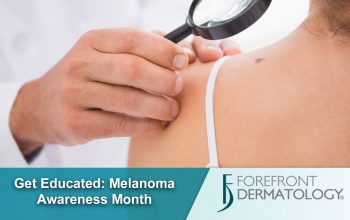Love the Skin You’re in This Valentine’s Day
As the cooler temperature and lower humidity of winter have been present for a couple months now, you are probably noticing some unfavorable changes to your skin’s appearance. According to Betsy Wernli, a board-certified dermatologist with Forefront Dermatology in Manitowoc, WI, “Winter is rough on the skin, with low humidity and freezing temperatures. Create an overall healthy lifestyle and daily […] Read More >
Get Your Beauty Rest: Sleep and the Skin
While you are sleeping, your skin has a chance to recover from the day by allowing blood to flow to the skin, offering countless benefits. According to Betsy Wernli, MD, a board-certified dermatologist with Forefront Dermatology, “strive for eight hours of rest each night. While sleeping, the body shifts its blood supply to the skin, providing increased circulation, allowing the […] Read More >
Sun Safety for a Spring Break Vacation at the Beach
If you are traveling to a warm destination for Spring Break, or even if you will be spending some extra time outdoors at home, it’s time to brush up on your sun safety tips. Remember, the sun’s rays are already getting very strong in spring during the peak hours of 10 a.m. to 4 p.m. If you are traveling to […] Read More >
Sun Safety for a Spring Break Vacation on the Slopes
Not all spring break vacations are on the beach. If you are taking a ski vacation this Spring Break, you have most likely thought of just about everything–but take a few minutes to review some information to protect your skin! Don’t Skimp on Sunscreen You can sunburn on a mountaintop just as easily as you can on a beach. Sunscreen […] Read More >
6 Tips to Help Control Your Hay Fever Symptoms
April showers bring May flowers… and pollen. Not only are we welcoming spring, we are also greeting allergy season. According to the Center for Disease Control and Prevention, over 25 million Americans suffer from hay fever each year. The following tips will help control those hay fever symptoms. 1. Pinpoint Your Allergy The first step in controlling the effects of […] Read More >
Top 3 Ways to Transition Your Skincare Routine to Spring
With every season comes change, and with spring upon us now is the time to change up your skincare regimen. With warmer temperatures it is common for skin to transition from dry to more oily. Follow these steps and you are on your way to having healthy, beautiful skin by summertime. 1. Unclog those Pores! During winter, the cold and […] Read More >
Ringworm: What You Need to Know
After covering Rash 101, we thought it would be a good idea to cover another type of rash, ringworm. Although this could have been shortly covered in Rash 101, we felt it needs its own moment in the spotlight because of its common appearance in summer, and its level of contagiousness. According to Andrea Garrett, MD, a board-certified Dermatologist with […] Read More >
Skin Cancer 101
Find it. Treat it. Beat it. May is Melanoma Awareness Month and with summer right around the corner, now is a great time to become more informed about skin cancer. There Are Two Skin Cancer Categories Skin cancer is defined by two categories, melanoma and non-melanoma. Melanoma is the most dangerous form of skin cancer and is the most likely […] Read More >
How to Perform a Self-Skin Check
Skin cancer does not discriminate by age, gender or ethnicity. It is important to know the signs of skin cancer and perform a monthly self-skin check to spot potential malignancies early. According to Sean Pattee, MD, Board-Certified Dermatologist and Fellowship-Trained Mohs Surgeon with Forefront Dermatology, “while skin cancer can occur anywhere on your body, approximately 85% of cases are located […] Read More >
Rash 101: The 5 Most Common Types of Skin Rashes
Skin rashes can occur because of a variety of factors including heat, infections, medications and environment stimulants. Here is a rundown of the most common types of skin rashes. Atopic Dermatitis Also known as Eczema, atopic dermatitis is a common skin disease in children. It is rare for adults to develop atopic dermatitis. According to the American Academy of Dermatology, […] Read More >










